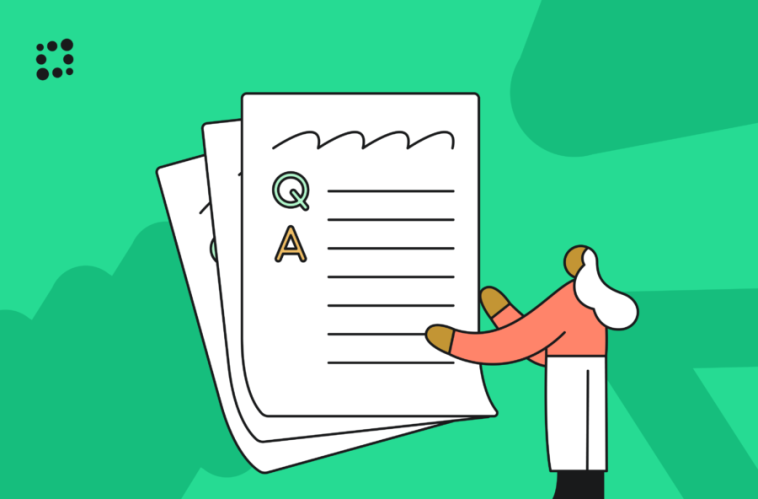- Like
- SHARE
- Digg
- Del
- Tumblr
- VKontakte
- Flattr
- Buffer
- Love This
- Save
- Odnoklassniki
- Meneame
- Blogger
- Amazon
- Yahoo Mail
- Gmail
- AOL
- Newsvine
- HackerNews
- Evernote
- MySpace
- Mail.ru
- Viadeo
- Line
- Comments
- Yummly
- SMS
- Viber
- Telegram
- JOIN
- Skype
- Facebook Messenger
- Kakao
- LiveJournal
- Yammer
- Edgar
- Fintel
- Mix
- Instapaper
- Copy Link
A client onboarding questionnaire helps you gather the information you need for excellent client relationships that promote long-term loyalty. Asking the right questions is key to effectively using this powerful customer success tool.
What Is a Client Onboarding Questionnaire?
A client onboarding questionnaire is a list of discovery questions administered to a new client to help you better serve their needs. It gathers business intelligence that can be used to assess a client’s needs, establish what goals they hope to achieve, and develop an action plan to meet their desired outcomes.
The contents of a client onboarding questionnaire vary by industry. In general, for B2B clients in the SaaS industry, a client onboarding questionnaire may probe into areas such as:
- Preferred contact personnel and information
- Information about the client’s products and services, features, and benefits
- A marketing analysis of the client’s target audience, marketing strategy, and competitors
- An analysis of the client’s workflow
- A review of the client’s automation needs and technology tools
- Identification of the client’s goals and KPIs used to measure progress
- Questions about the client’s budget
This list is illustrative but not exhaustive. Depending on the nature of your product and your client’s business model, you may ask questions about any relevant area of their business.
Client onboarding questionnaires are usually administered shortly after the client becomes a paying client or, in some cases, during a sales discovery session. Questionnaires may be administered digitally or manually, with digital forms representing the most efficient option for integrating your questionnaire into your onboarding workflow.
Why Create a Client Onboarding Questionnaire?
Using a client onboarding questionnaire offers numerous advantages, particularly for companies in the B2B SaaS industry. A client onboarding questionnaire can help you:
- Make a smooth handoff between your sales team and your customer success team
- Build rapport with new clients, setting the stage for a mutually beneficial relationship
- Reinforce trust by demonstrating that you have a transparent process for knowledge acquisition
- Establish clear communication patterns with your new client
- Increase communication efficiency by identifying your client’s preferred contact person and method
- Document communication for reference and transparency
- Close information gaps
- Open up brainstorming discussions that stimulate new insights
- Assess client needs
- Set client goals
- Develop more effective solutions to achieve client objectives
- Establish client expectations
- Deliver more satisfying results, which promote repeat business
This wide range of compelling benefits makes client onboarding questionnaires invaluable for B2B SaaS brands.
What Are the Goals of a Client Onboarding Questionnaire?
When crafting your onboarding questionnaire questions and procedures, it will be helpful to bear in mind a few priority objectives. An onboarding questionnaire serves to:
- Promote a clean handoff between your sales and customer success teams: Many companies miss a golden opportunity, says onboarding expert Donna Weber of Springboard Solutions. “As soon as a deal closes, most teams dive into the technical weeds of implementing the product,” Weber explains. “They miss out on transferring the relationship. Before you build anything else out, start with the hand-offs.” This advice underscores how an onboarding questionnaire can fill the gap in your customer journey map between a new client’s purchase of your product and the start of their experience as a paying client. Moreover, information collected by your sales team during the marketing and sales process may overlap significantly with the information sought by your onboarding questionnaire concerning information such as client needs, goals, and budgets. Sharing information between your sales and customer success teams, which Weber calls an “internal handoff,” can promote a cleaner handoff between the pre-purchase and post-purchase phases of your customer’s lifecycle. In this case, your onboarding questionnaire can serve to follow up and expand upon information collected by your sales team. In some cases, you may even find it strategic to build your discovery questionnaire into your sales process, either in part or in full. No matter which approach you take, your questionnaire should transition your client and your team smoothly from the sales phase of the customer lifecycle to the customer success phase. Weber recommends that your internal handoff be followed by an “external handoff” where your sales representative introduces your client to your post-sales customer success team.
- Facilitate a clear knowledge transfer between you and your client: A primary purpose of your onboarding questionnaire is to collect business intelligence relevant to serving your client’s needs to deliver better service. A questionnaire helps standardize your information-gathering procedures and document the information you collect. This ensures that all essential bases are covered. It can also create a framework to stimulate brainstorming that addresses problems and solutions you and your client had not considered before going through the questionnaire process. Last, but not least, it provides a documented reference for future use to help you implement your customer success strategy and track performance.
- Establish transparent expectations of what you and your client expect from each other: An onboarding questionnaire provides you with a clearer idea of what your client is hoping to achieve by using your product. At the same time, it helps you communicate what you’re aiming to deliver to your client and what falls outside of this scope. This can be quantified through key performance indicators which measure progress toward client goals. Such documentation can be invaluable for later performance reviews, such as quarterly business reviews.
Keeping these and any other objectives in mind will help you select strategic questions in your questionnaire. It also will help you decide where to have your questionnaire in your customer journey and how to deliver it. Whether your client is self-served, low-touch, or high-touch, you may wish to make the questionnaire process entirely automated or include guidance from team members.
What Questions Should a Client Onboarding Questionnaire Include?
The exact questions you should ask vary depending on your product and your client. In general, for B2B SaaS providers, questions should gather information about topics such as your client’s:
- Preferred contact personnel
- Product features and benefits
- Marketing strategy
- Internal workflow
- Automation needs
- Business goals relevant to the use of your product
- KPIs for measuring progress toward goals
- Budget
Here is a sample list of questions falling into these categories. Use this list to customize your questionnaire, adding any categories or questions relevant to your specific needs.
- Who is your preferred primary contact, and what contact information should our team use to contact them?
- Do you have a secondary contact we should use when your primary contact is unavailable? If so, please include contact information.
- What product, solution, or service do you sell?
- What are the main features of your products?
- What benefits do your products offer clients?
- What is your brand’s unique selling proposition?
- What are the three main segments of your target audience?
- How would you describe your ideal buyer?
- Who are your three top competitors? List any direct or indirect competitors to help us understand the competitive landscape of your business.
- What main marketing channels do you use to reach your target audience?
- What are the key steps in your internal workflow?
- What are the main types of automation you incorporate into your workflow?
- Where will our product fit into your workflow?
- What goals do you hope our product will help you achieve?
- What key performance indicators will you use to measure the results of using our product?
- With respect to these key performance indicators, what numbers would represent a satisfactory result from using our product?
- What would you consider a reasonable target date for achieving these numbers?
- If we can help you achieve these numbers within this time frame, would you be inclined to renew your subscription to our product?
- Who at your company will be responsible for performance reviews of your use of our product?
- What is your budget for your use of our product?
Not all these questions will apply to all business models and clients. Strive to restrict your list to the questions most relevant to your needs. The shorter your questionnaire, the more likely your clients will be to complete it promptly.
Your question list may be preceded by a brief introductory statement with instructions on your form. For example, you may tell your client that you’re asking these questions to serve them better and then provide them with instructions on how to transmit the form to you when they’re done answering questions.
Enhance Your Client Onboarding with Automated Customer Success
Technology can assist you greatly in administering your questionnaire and increasing your efficiency in collecting and deploying information. Two types of technology are beneficial:
- Form builder software
- Customer success platforms
Form builder software automates designing forms, sharing them with clients, collecting client responses, and analyzing the results. Leading form builder software products include Microsoft Forms, Google Forms, Jotform, and Typeform.
Customer success platforms help you automate best practices for your customer journey by combining automated workflows with key performance indicators. Standard procedures get triggered at the appropriate points in your customer’s journey. This lets you automate the delivery of questionnaire forms and trigger automatic actions based on form results. Today’s leading customer success platform provider is Totango, which provides out-of-the-box onboarding workflows and KPIs you can use to integrate your questionnaires into an optimized onboarding process.
Totango’s customer success platform includes everything you need to build your questionnaire into an optimized onboarding workflow. Get started free to automate your onboarding questionnaire process for greater client success and higher client retention.





